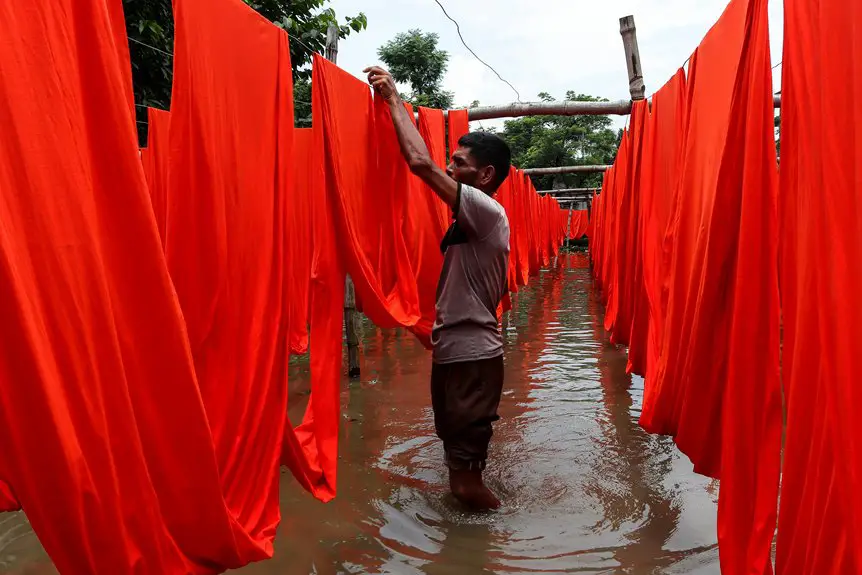To set color in fabric and prevent bleeding, use dye fixatives like salt or vinegar. Mix one part vinegar with four parts water to pre-soak your fabric before dyeing. Immerse your fabric in simmering dye, ensuring full submersion for even color. After dyeing, rinse in cold water until it runs clear, and avoid high heat during washing. Iron on low heat to set the dye. Discover more tips and techniques to keep your colors vivid and long-lasting.
Table of Contents
Key Takeaways
- Use a dye fixative like salt or vinegar after dyeing to lock in colors and prevent bleeding.
- Rinse dyed fabric in cold water until the water runs clear to remove excess dye.
- Pre-soak fabrics in cold water before dyeing for even absorption and reduced bleeding.
- Wash dyed fabrics separately in cold water using gentle, non-toxic detergents to maintain color.
- Iron the fabric on low heat with a cloth in between to set the dye and prevent bleeding.
Understanding Dye Fixatives
When you’re working with fabric dye, understanding dye fixatives is crucial to achieving vibrant, long-lasting colors.
Dye fixatives help bind the dye to the fabric, preventing it from fading or bleeding during washing. There are various types, including salt, vinegar, and commercial fixatives, each suited for different fabrics and dyes.
Dye fixatives are essential for securing color to fabric, reducing fading and bleeding during washes.
When using salt for cotton, for instance, dissolve it in water before soaking the fabric. If you opt for vinegar, a mixture of one part vinegar to four parts water will do the trick.
Always follow the manufacturer’s instructions for commercial fixatives, as they can vary.
Techniques for Immersion Dyeing
Although immersion dyeing may seem intimidating at first, it’s a straightforward technique that yields stunning results.
To get started, gather your fabric, dye, and a large pot. Fill the pot with water, and heat it to a simmer. Once it’s ready, add your dye according to the package instructions.
Submerge your fabric, ensuring it’s fully immersed. Stir gently for even color distribution, and let it soak for the recommended time. Keep an eye on the color, as it can deepen quickly.
After dyeing, rinse the fabric in cold water until the water runs clear, then wash it with a mild detergent. Finally, hang it to dry away from direct sunlight to preserve the color.
Enjoy your beautifully dyed fabric!
Natural vs. Synthetic Dye Methods
After mastering immersion dyeing, you might wonder about the differences between natural and synthetic dye methods. Each has its unique benefits and drawbacks, so it’s essential to choose what works best for your project.
- Natural Dyes: Eco-friendly and derived from plants, insects, or minerals. They often produce soft, muted colors.
- Synthetic Dyes: Man-made and usually more vibrant with a broader range of colors. They often provide better colorfastness.
- Application: Natural dyes may require more preparation and mordants to fix the color, while synthetic dyes can be more straightforward.
- Cost: Natural materials can be pricier and less accessible than synthetic options, which are widely available.
Understanding these differences helps you make informed choices for your fabric dyeing endeavors.
Post-Dyeing Care Tips
To guarantee your newly dyed fabric retains its vibrant colors, proper post-dyeing care is essential. Start by washing the fabric separately in cold water to remove any excess dye. Avoid using harsh detergents—opt for a gentle one instead. When drying, hang your fabric in the shade to prevent sun fading. If you need to iron, use a low heat setting and place a cloth between the iron and the fabric.
Here’s a quick reference table for your post-dyeing care:
| Care Tip | Action |
|---|---|
| Wash | Cold water, separately |
| Detergent | Gentle, non-toxic |
| Drying | Hang in shade |
| Ironing | Low heat, use cloth |
| Storage | Cool, dark place |
Following these tips will help keep your colors looking fresh!
Preventing Color Bleeding
To keep your fabric colors vibrant, you’ll want to focus on temperature control and using fixatives.
Proper heat settings during dyeing can markedly impact color absorption and stability.
Additionally, applying a fixative can help lock in those hues and prevent unwanted bleeding.
Temperature Control Techniques
While you might be excited to experiment with DIY fabric dyeing, temperature control plays an essential role in preventing color bleeding. By carefully managing temperature during the dyeing process, you can help set the colors more effectively.
Here are some tips to help you maintain ideal temperatures:
- Use cold water for rinsing: This helps lock in the dye and reduces the risk of bleeding.
- Avoid high heat when washing: Hot water can promote bleeding, so stick to cold or lukewarm washes.
- Pre-soak fabrics in cold water: This prepares the fibers to absorb dye evenly.
- Set dyes with heat: After dyeing, use an iron on low heat to help set the colors without causing bleeding.
Keep these techniques in mind for vibrant, lasting results!
Fixatives for Color Stability
After mastering temperature control techniques, it’s time to focus on fixatives that enhance color stability and prevent bleeding.
Fixatives are essential for locking in dyes and ensuring your fabric maintains its vibrant hues. You can use commercial fabric fixatives, which are easy to apply and effective. Alternatively, consider natural options like vinegar or salt, which can help set colors without harsh chemicals.
Simply soak your dyed fabric in a mixture of water and your chosen fixative before rinsing it out. Remember to follow the manufacturer’s instructions or use a 1:4 ratio for natural fixatives.
Testing Colorfastness
How can you guarantee the colors you’ve added to your fabric will stand the test of time? The answer lies in testing colorfastness.
Before you fully commit to a project, it’s smart to check if your chosen dyes bleed or fade. Here are a few simple methods to test your fabric’s color stability:
- Water Test: Dampen a white cloth and rub it against your dyed fabric. If color transfers, it’s not colorfast.
- Bleach Test: Apply a diluted bleach solution to a small area. If the color changes, it may not hold up.
- Sunlight Test: Expose a small section to sunlight for several hours. If it fades, you’ll need a fixative.
- Washing Test: Wash a sample piece with similar fabrics. Check for any color bleeding.
Testing guarantees your creations last!
Frequently Asked Questions
Can I Use Regular Salt for Dye Fixation?
You can use regular salt for dye fixation, but its effectiveness varies. It helps enhance color retention in some fabrics, yet it’s not a guaranteed solution. Experimenting with different methods may yield better results.
How Long Should I Soak Fabric in Vinegar?
Soaking fabric in vinegar is like planting seeds in nutrient-rich soil. You should soak it for about 30 minutes to an hour; this helps set the dye and guarantees vibrant colors flourish in your projects.
What Is the Best Temperature for Dyeing Fabric?
The best temperature for dyeing fabric typically ranges from 140°F to 200°F. Adjusting the water temperature helps the dye bond effectively with the fibers, ensuring vibrant and long-lasting colors in your projects.
Can I Dye Synthetic Fabrics With Natural Dyes?
You can dye synthetic fabrics with natural dyes, but it’s tricky. Synthetic fibers often resist natural dyes, so using a mordant or synthetic dye specifically designed for those fabrics might yield better results for vibrant colors.
How Do I Know if My Dye Is Colorfast?
To know if your dye’s colorfast, you can perform a simple test. Dampen a small fabric piece, rub it against a white cloth, and check for color transfer. If there’s none, your dye’s likely colorfast.
- The History and Evolution of Chamois Fabric - June 22, 2025
- Chamois Fabric on Wikipedia: What You Need to Know - June 22, 2025
- How to Pronounce Chamois Fabric Correctly - June 22, 2025







